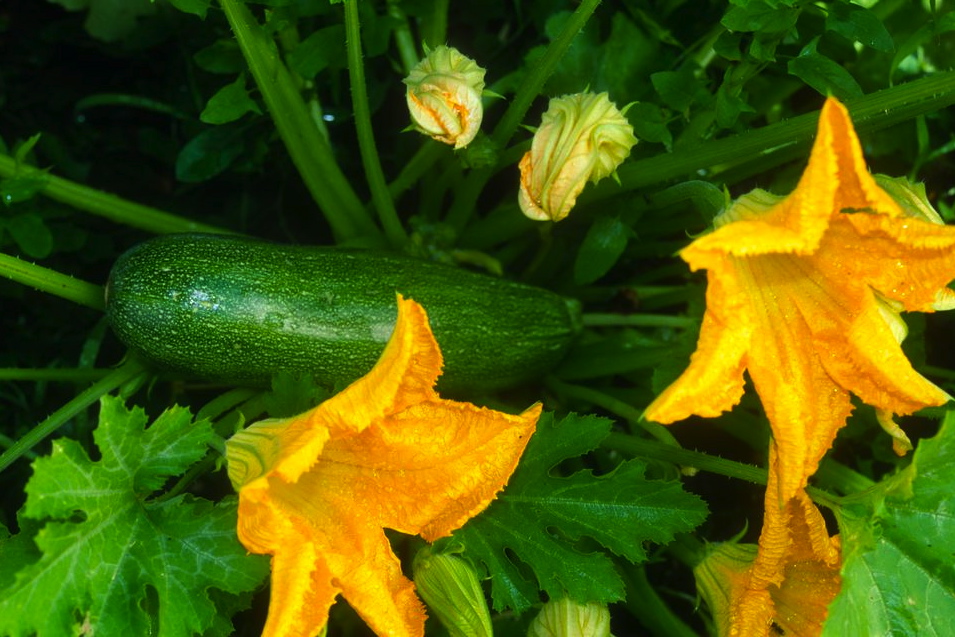
Once July really kicks in, the goodies keep coming if you’ve done all your earlier spadework – early crops to pick, fruit ripening and flowers everywhere! But no time to rest on your laurels – let’s have a go at pruning the plum trees, taking semi-ripe cuttings and harvesting courgettes, amongst other jobs …….
PRUNING THE PLUM TREES
There’s a nasty disease that plum trees are prone to, called Silver Leaf. If you see a silvery sheen on any leaves or a purple-white fungus on the branches, you must remove those branches immediately before the whole tree succumbs.

The easiest way to make your tree susceptible to that particular nasty is to prune it in winter. So, DON’T!! Prune it now instead. Young trees should be pruned in spring while they are still being trained into a good shape and to fruit well, but on an established tree, this is a good time to use secateurs to cut back this season’s growth of the main shoots (‘leaders’) to half their length, pruning to just above a leaf.
Then prune or pinch out the sideshoots back to 2-3 buds from the base of the new growth.
SPLENDIFEROUS SEMI-RIPES!
July is also a great time to take a mass of cuttings which are known as ‘semi-ripe’ because the material you use will have hard wood at its base formed during the current season, but the tip will still be soft. I actually think that these are much easier that softwood cuttings, simply because they don’t demand so much attention!
There are just heaps of things that can be propagated by semi-ripe cuttings: climbers such as Passion flower, Solanum and Trachelospermum; evergreen shrubs such as Hebe, Fatsia, Viburnum, Berberis, Ceonothus etc.; hedging like laurel and privet ( how about propagating your own native hedge?!); woody herbs like sage, rosemary and thyme; even trees like Magnolia grandiflora, holly and conifers. Honestly, it’s worth having a go with anything!

1. In the morning, when plants are turgid, cut below a leaf with a sharp knife of secateurs, giving you a stem 4-6″ long. Put all your cuttings straightaway into a plastic bag to stop them wilting, and put them into compost within 12 hours.
2. Take the bottom leaves off your cutting and cut any big leaves in half to reduce transpiration. Nip out the growing tip if it is very soft. I don’t bother with hormone rooting powder any more, but if you want to, dip the bottom of the cutting in the powder until it’s well-covered.
3. Tuck your cuttings into pots of free-draining gritty compost, water them, label them, and put the pots into the greenhouse or on a warm, bright windowsill out of direct sunlight and covered with a clear plastic bag.
You can take these cuttings right up to mid-autumn, so please do have a go – it’s immensely satisfying when they root!
COURGETTE HARVEST
Aren’t courgette flowers utterly fabulous! And edible too, of course. And picking your own courgettes is also pretty wonderful, but you do need to keep doing it. If you leave them to get big or even turn into marrows, the plant will think it has done its job and will stop flowering prematurely. Don’t let them get beyond about 20 cm (8″) and this will keep the plant producing female flowers too. Pinch off any male flowers which are the ones without a teeny courgette behind them.

Harvest your small courgettes early in the morning while they are still full of water by cutting them at the base with a sharp knife. It’s a good tip to keep them in the top of the fridge so that they don’t become overchilled.
Your plants will appreciate being kept well-watered, and given a weekly tomato feed. Look after your courgettes and they will reward you with an excellent crop.
GARDENING SHORTS
* We all like a good drink (!) and it’s been particularly dry in our neck of the woods recently, so watering has been important. But for plants in the ground, a long deep drink twice a week will do far more good than a sprinkle every day, encouraging their roots downwards.
* Try to be vigilant about aphids, blackfly etc. and squirt them off with a jet of water before they do too much harm.
* While you’re drifting around in a picture hat deadheading the roses, do the same for summer perennials like Knautia and Lychnis– if you can be bothered, you will be thrilled for how much longer you can persuade them to flower!

[jetpack_subscription_form title=”The3Growbags” subscribe_text=”If you’d like to keep up to date with the3growbags gardening chit-chat just pop your email address in here” subscribe_button=”and click!”]
